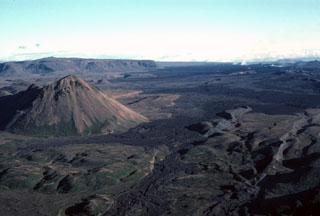Report on Krafla (Iceland) — August 1984
Scientific Event Alert Network Bulletin, vol. 9, no. 8 (August 1984)
Managing Editor: Lindsay McClelland.
Krafla (Iceland) Eruption from 8.5-km fissure
Please cite this report as:
Global Volcanism Program, 1984. Report on Krafla (Iceland) (McClelland, L., ed.). Scientific Event Alert Network Bulletin, 9:8. Smithsonian Institution. https://doi.org/10.5479/si.GVP.SEAN198408-373080
Krafla
Iceland
65.715°N, 16.728°W; summit elev. 800 m
All times are local (unless otherwise noted)
"After a quiet interval of 2 years and 9 months, an eruption broke out at Krafla on 4 September 1984. The eruption in November 1981 (6:11) and associated deflation of magma reservoirs below Leirhnjúkur were followed by inflation, reaching previous levels in early 1982. Since then slow and intermittent inflation has continued, accompanied by earthquakes in the reservoir roof.
"Rapid deflation over the magma reservoirs followed by volcanic tremor began 4 September at about 2025, but the eruption broke out at 2349. The beginning of the eruption was observed from the air by alerted scientists and a television reporter. The first fissure segment opened about 6 km N of Leirhnjúkur, followed within a minute by another about 3 km to the S. The fissures quickly joined and in 1 hour reached their full length of 8.5 km, extending from Leirhnjúkur to the N. During the first hours lava was erupted along the whole fissure, advancing on broad fronts.
"Already in the early hours of the morning, the activity had decreased and lava production on various sections of the fissures had faded out. By midday on 5 September, inflation had resumed. By 6 September, eruption on the S part of the fissure had ceased except on one crater, which then changed into phreatic activity.
"By 8 September, inflation rates over the magma chambers diminished and slow deflation started [but see 9:11]. On the northernmost part of the fissure, activity continued as of the morning of 12 September with significant lava production.
"As in previous eruptions, lava production was highest on the northern part of the fissure and has so far not constituted any threat to inhabited areas."
Geological Summary. The Krafla volcanic system in the Northern Volcanic Zone (NVZ) of Iceland is about 100 km long, consisting of a fissure swarm and a central volcano with a 7 x 9 km caldera formed about 110,000 years ago that deposited a rhyolitic welded tuff. It has been moderately active in the Holocene, over three distinct eruptive periods; the current one has lasted about 2,800 years with six volcano-tectonic episodes, each with one or more basaltic fissure eruptions. Lava volumes (DRE) have been in the 0.1-1 km3 range. The Hverfjall and Ludent tuff rings east of Myvatn were erupted along the fissure system. Myvatn lake formed during the eruption of the older Laxarhraun lava flow from the Ketildyngja shield volcano of the Fremrinamur volcanic system about 3,800 years before present (BP); The present Myvatn lake is constrained by the roughly 2,000 years BP younger Laxarhraun lava flow from the Krafla volcanic system. The abundant pseudocraters that form a prominent part of the Myvatn landscape were created when the younger Laxarhraun lava flow entered the lake. The last eruption took place in 1975-1984 CE when nine small basaltic fissure eruptions produced 0.25 km3 of lava.
Information Contacts: K. Grönvold, NVI; P. Einarsson, Univ. of Iceland.

